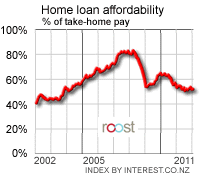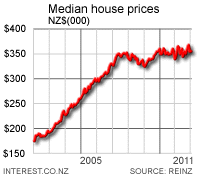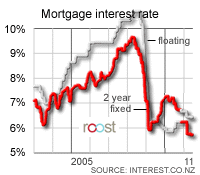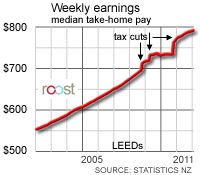 New Zealand home loan affordability was steady in February from January as house prices and interest rates were broadly unchanged, Interest.co.nz’s Home Loan Affordability report shows.
The housing market remains stuck in a ‘Mexican Standoff’ between buyers and sellers who are both wary of possible tax changes in the May 20 budget and future interest rate rises.
Affordability was mostly unchanged in the major cities, although house price rises in Nelson/Marlborough and around Queenstown worsened affordability in those areas.
Affordability is better than its worst levels hit in early 2007 near the peak of the housing boom and interest rates, but has deteriorated in the last six months as house prices rebounded in the wake of interest rate cuts, the monthly measure calculated by Interest.co.nz found.
“There is a Mexican Standoff in the housing market where some buyers are holding off until after the May 20 Budget and sellers are reluctant to accept price reductions after the rebound in late 2009,” said Interest.co.nz Editor Bernard Hickey.
“However, the pressure is mounting for price falls as swathes of new listings have hit the market in February and March and many buyers are preparing for higher variable mortgage rates later in 2010,” Hickey said.
New Zealand home loan affordability was steady in February from January as house prices and interest rates were broadly unchanged, Interest.co.nz’s Home Loan Affordability report shows.
The housing market remains stuck in a ‘Mexican Standoff’ between buyers and sellers who are both wary of possible tax changes in the May 20 budget and future interest rate rises.
Affordability was mostly unchanged in the major cities, although house price rises in Nelson/Marlborough and around Queenstown worsened affordability in those areas.
Affordability is better than its worst levels hit in early 2007 near the peak of the housing boom and interest rates, but has deteriorated in the last six months as house prices rebounded in the wake of interest rate cuts, the monthly measure calculated by Interest.co.nz found.
“There is a Mexican Standoff in the housing market where some buyers are holding off until after the May 20 Budget and sellers are reluctant to accept price reductions after the rebound in late 2009,” said Interest.co.nz Editor Bernard Hickey.
“However, the pressure is mounting for price falls as swathes of new listings have hit the market in February and March and many buyers are preparing for higher variable mortgage rates later in 2010,” Hickey said.
 The Home Loan Affordability measure for all of New Zealand showed the proportion of a single median after tax income needed to service an 80% mortgage on a median house was unchanged at 62.1%.
The median house price as measured by REINZ was steady in February at NZ$350,000, just off a record high NZ$360,000 hit in December and 7.7% above its January 2009 trough of NZ$325,000. The average 2 year fixed mortgage rate, which has been among the most popular with borrowers in recent years, was basically unchanged at 7.26% over the month and is up from an average 5.92% in February last year.
Variable mortgage rates, meanwhile, nudged lower to an average 5.86% in February from 5.95% in January and are now at their lowest level in at least 7 years, meaning some borrowers may choose to go variable rather than fixed to improve their immediate affordability.
Affordability hit its worst level of 83.4% in March 2008 just after house prices peaked and 2 year mortgage rates were close to 10%. Many home buyers jumped in March, April and May of 2009 to take advantage of lower interest rates and look for bargains, which improved the number of houses sold and boosted prices. But short term mortgage interest rates flattened out in late March and longer term mortgage rates began to rise in line with rises on wholesale markets and higher local term deposit rates.
The Home Loan Affordability measure for all of New Zealand showed the proportion of a single median after tax income needed to service an 80% mortgage on a median house was unchanged at 62.1%.
The median house price as measured by REINZ was steady in February at NZ$350,000, just off a record high NZ$360,000 hit in December and 7.7% above its January 2009 trough of NZ$325,000. The average 2 year fixed mortgage rate, which has been among the most popular with borrowers in recent years, was basically unchanged at 7.26% over the month and is up from an average 5.92% in February last year.
Variable mortgage rates, meanwhile, nudged lower to an average 5.86% in February from 5.95% in January and are now at their lowest level in at least 7 years, meaning some borrowers may choose to go variable rather than fixed to improve their immediate affordability.
Affordability hit its worst level of 83.4% in March 2008 just after house prices peaked and 2 year mortgage rates were close to 10%. Many home buyers jumped in March, April and May of 2009 to take advantage of lower interest rates and look for bargains, which improved the number of houses sold and boosted prices. But short term mortgage interest rates flattened out in late March and longer term mortgage rates began to rise in line with rises on wholesale markets and higher local term deposit rates.
 House sales volumes flattened off in the last three months of 2009 and early 2010 as first home buyers and rental investors stayed away, leaving most of the activity at the top end for owner-occupiers using equity stored up during the 2002-07 boom, or trading down to reduce debt. Volumes slumped in January and February sales were their lowest since REINZ records began in 1992.
Affordability is now often out of reach for most home buyers in the big cities on a single income. The threshold proportion of after tax income considered prudent to sustainably own a house is around 40%. Anything above that is starting to become unaffordable.
Affordability for the typical first-home-buyer improved slightly in February from January. The proportion of a single after tax pay needed to buy a first quartile house fell to 53.8% from 55%. The first quartile house price fell to NZ$250,275 from NZ$255,000 in January. This measure is for a median income earner aged 25-29 buying a first quartile home. Interest.co.nz thinks the ‘affordable' threshold is 40% for such a home buyer.
House sales volumes flattened off in the last three months of 2009 and early 2010 as first home buyers and rental investors stayed away, leaving most of the activity at the top end for owner-occupiers using equity stored up during the 2002-07 boom, or trading down to reduce debt. Volumes slumped in January and February sales were their lowest since REINZ records began in 1992.
Affordability is now often out of reach for most home buyers in the big cities on a single income. The threshold proportion of after tax income considered prudent to sustainably own a house is around 40%. Anything above that is starting to become unaffordable.
Affordability for the typical first-home-buyer improved slightly in February from January. The proportion of a single after tax pay needed to buy a first quartile house fell to 53.8% from 55%. The first quartile house price fell to NZ$250,275 from NZ$255,000 in January. This measure is for a median income earner aged 25-29 buying a first quartile home. Interest.co.nz thinks the ‘affordable' threshold is 40% for such a home buyer.
 Meanwhile, affordability for households with more than one income was steady at levels last seen at the end of 2008. This measure of a ‘standard typical household' found the proportion of after tax income needed to service the mortgage on a median house was steady at 40.8%. This measure assumes one median male income, half a median female income aged 30-35 and a 5 year old child that receives Working-for-Families benefits.
This remains near the worst level of standard household affordability since November last year and significantly above the 35% trough seen in January, February and March, when buyer demand returned to the housing market. Any level over 40% is considered unaffordable for a household.
Our measure of a ‘standard first-home-buyer household' found the proportion of after tax income needed to service the mortgage on a first quartile home rose was 25.5% in February, down from 26.1% in January because of the fall in the lower quartile house price.
It has worsened from its best levels of 22% in February and March when some first-home-buyers returned to the market. This measure peaked at 35% in June 2007. This measure assumes a first home buyer household includes a median male income and a median female income aged 25-29 with no children. Any level over 30% is considered unaffordable in the longer term for such a household.
Southland remains the most affordable region for home buyers with a standard affordability measure of 36.4%, while the Central Otago Lakes (Wanaka and Queenstown) is the least affordable on 83.1%. Auckland worsened marginally in February to 75.6% from 75.1%, while Wellington worsened the most of the big cities to 64.4% from 61.6% in January. Christchurch affordability improved slightly to 55.7% from 58.4%.
Meanwhile, affordability for households with more than one income was steady at levels last seen at the end of 2008. This measure of a ‘standard typical household' found the proportion of after tax income needed to service the mortgage on a median house was steady at 40.8%. This measure assumes one median male income, half a median female income aged 30-35 and a 5 year old child that receives Working-for-Families benefits.
This remains near the worst level of standard household affordability since November last year and significantly above the 35% trough seen in January, February and March, when buyer demand returned to the housing market. Any level over 40% is considered unaffordable for a household.
Our measure of a ‘standard first-home-buyer household' found the proportion of after tax income needed to service the mortgage on a first quartile home rose was 25.5% in February, down from 26.1% in January because of the fall in the lower quartile house price.
It has worsened from its best levels of 22% in February and March when some first-home-buyers returned to the market. This measure peaked at 35% in June 2007. This measure assumes a first home buyer household includes a median male income and a median female income aged 25-29 with no children. Any level over 30% is considered unaffordable in the longer term for such a household.
Southland remains the most affordable region for home buyers with a standard affordability measure of 36.4%, while the Central Otago Lakes (Wanaka and Queenstown) is the least affordable on 83.1%. Auckland worsened marginally in February to 75.6% from 75.1%, while Wellington worsened the most of the big cities to 64.4% from 61.6% in January. Christchurch affordability improved slightly to 55.7% from 58.4%.
 Watch on YouTube here
Watch on YouTube here
NZ home loan affordability steady in February’s ‘Mexican Standoff’
NZ home loan affordability steady in February’s ‘Mexican Standoff’
23rd Mar 10, 2:28pm
by

We welcome your comments below. If you are not already registered, please register to comment
Remember we welcome robust, respectful and insightful debate. We don't welcome abusive or defamatory comments and will de-register those repeatedly making such comments. Our current comment policy is here.